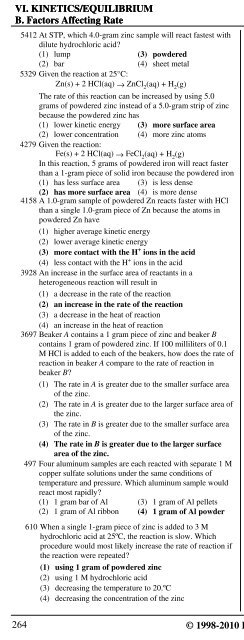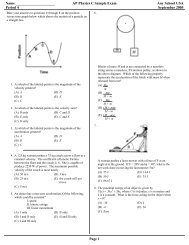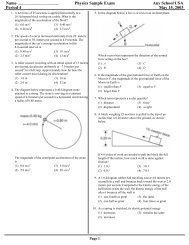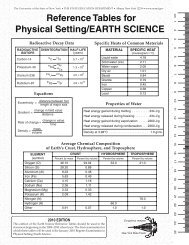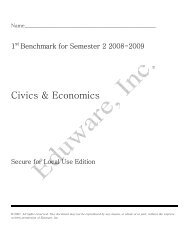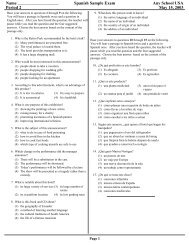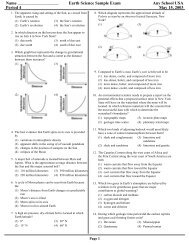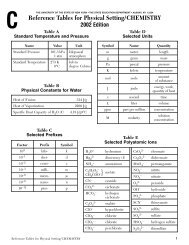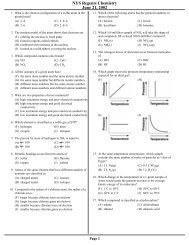Wizard Test Maker - Eduware
Wizard Test Maker - Eduware
Wizard Test Maker - Eduware
- No tags were found...
You also want an ePaper? Increase the reach of your titles
YUMPU automatically turns print PDFs into web optimized ePapers that Google loves.
VI. KINETICS/EQUILIBRIUM 1. Rates of ReactionsB. Factors Affecting Rate iii. Surface Area5412 At STP, which 4.0-gram zinc sample will react fastest withdilute hydrochloric acid?(1) lump (3) powdered(2) bar (4) sheet metal5329 Given the reaction at 25°C:Zn(s) + 2 HCl(aq) → ZnCl 2(aq) + H 2(g)The rate of this reaction can be increased by using 5.0grams of powdered zinc instead of a 5.0-gram strip of zincbecause the powdered zinc has(1) lower kinetic energy (3) more surface area(2) lower concentration (4) more zinc atoms4279 Given the reaction:Fe(s) + 2 HCl(aq) → FeCl 2(aq) + H 2(g)In this reaction, 5 grams of powdered iron will react fasterthan a 1-gram piece of solid iron because the powdered iron(1) has less surface area (3) is less dense(2) has more surface area (4) is more dense4158 A 1.0-gram sample of powdered Zn reacts faster with HClthan a single 1.0-gram piece of Zn because the atoms inpowdered Zn have(1) higher average kinetic energy(2) lower average kinetic energy(3) more contact with the H + ions in the acid(4) less contact with the H + ions in the acid3928 An increase in the surface area of reactants in aheterogeneous reaction will result in(1) a decrease in the rate of the reaction(2) an increase in the rate of the reaction(3) a decrease in the heat of reaction(4) an increase in the heat of reaction3697 Beaker A contains a 1 gram piece of zinc and beaker Bcontains 1 gram of powdered zinc. If 100 milliliters of 0.1M HCl is added to each of the beakers, how does the rate ofreaction in beaker A compare to the rate of reaction inbeaker B?(1) The rate in A is greater due to the smaller surface areaof the zinc.(2) The rate in A is greater due to the larger surface area ofthe zinc.(3) The rate in B is greater due to the smaller surface areaof the zinc.(4) The rate in B is greater due to the larger surfacearea of the zinc.497 Four aluminum samples are each reacted with separate 1 Mcopper sulfate solutions under the same conditions oftemperature and pressure. Which aluminum sample wouldreact most rapidly?(1) 1 gram bar of Al (3) 1 gram of Al pellets(2) 1 gram of Al ribbon (4) 1 gram of Al powder610 When a single 1-gram piece of zinc is added to 3 Mhydrochloric acid at 25ºC, the reaction is slow. Whichprocedure would most likely increase the rate of reaction ifthe reaction were repeated?(1) using 1 gram of powdered zinc(2) using 1 M hydrochloric acid(3) decreasing the temperature to 20.ºC(4) decreasing the concentration of the zinc3111 As the surface area of the Zn(s) used in the reactionZn(s) + 2 HCl(aq) → ZnCl 2(aq) + H 2(g)is increased, the rate of the reaction will(1) decrease (3) remain the same(2) increase2730 Base your answer to the following question on the tablebelow, which represents the production of 50 milliliters ofCO 2in the reaction of HCl with NaHCO 3. Five trials wereperformed under different conditions as shown. (The samemass of NaHCO 3was used in each trial.)Which trial would produce the fastest reaction?(1) trial A (3) trial C(2) trial B (4) trial D1743 Charcoal reacts with oxygen according to the equationC(s) + O 2(g) → CO 2(g).Which of the following changes would cause the greatestincrease in the rate of reaction?(1) decreasing the concentration of O 2(g)(2) decreasing the pressure of O 2(g)(3) using charcoal in powdered form(4) using charcoal in lump form1229 Given the reaction:CuSO 4(s) ↔ Cu 2+ (aq) + SO 2– (aq)The CuSO 4(s) dissolves more rapidly when it is powderedbecause the increased surface area due to powdering permits(1) increased solvent contact(2) increased solute solubility(3) the equilibrium to shift to the left(4) the equilibrium to shift to the right1061 Which statement explains why the speed of some chemicalreactions is increased when the surface area of the reactantis increased?(1) This change increases the density of the reactantparticles.(2) This change increases the concentration of the reactant.(3) This change exposes more reactant particles to apossible collision.(4) This change alters the electrical conductivity of thereactant particles.264© 1998-2010 <strong>Eduware</strong>, Inc.


